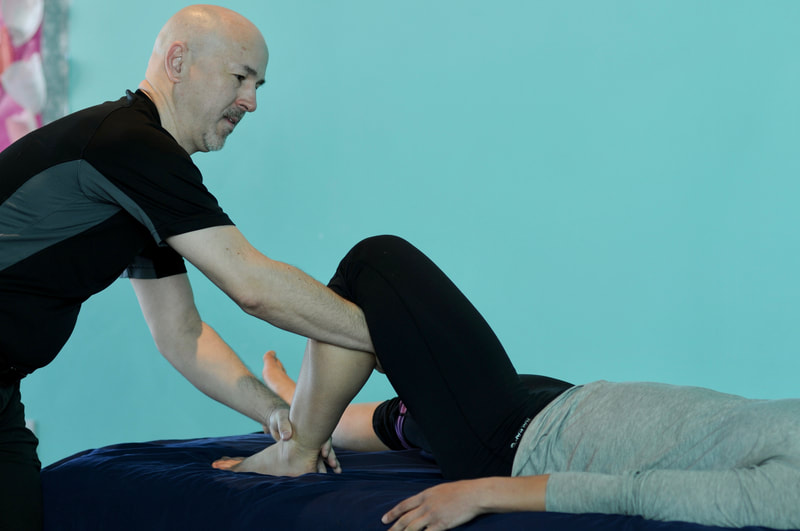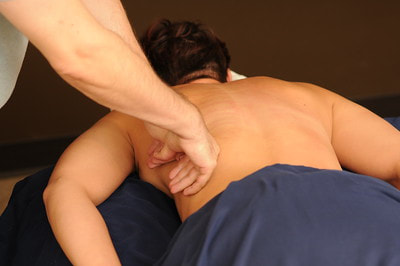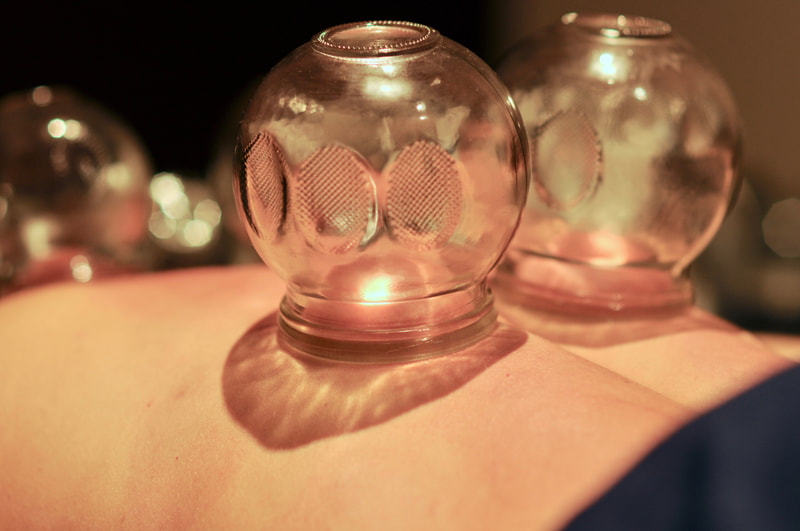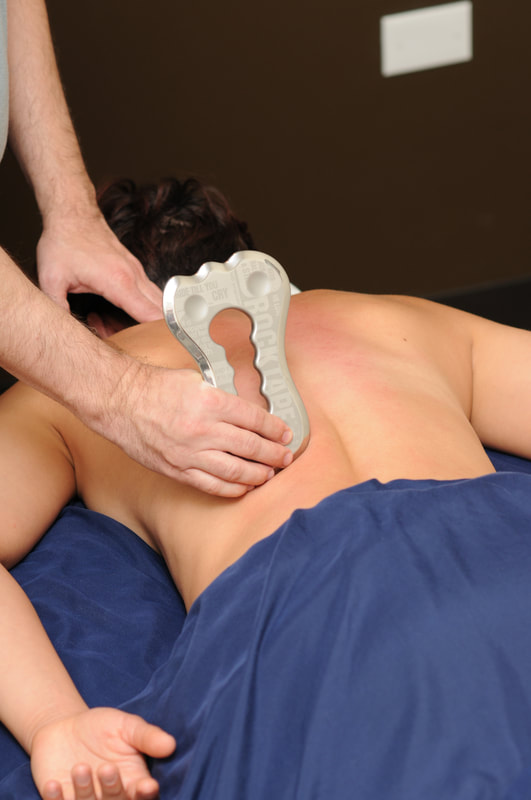About sports massage:
What is sports massage?:
Sports massage is a form of massage that utilizes specific strokes including assisted stretching, active and passive movement as well as deep tissue techniques to help athletes obtain maximum performance and physical conditioning by increasing power, endurance, and mobility—both before and after an event or exercise.
Who Can Benefit?:
Sports massage is particularly beneficial when an athlete is in training for an event. It’s also helpful for anyone who routinely stretches physical limits through movement. Swimmers, weight lifters, runners, golfers, ball players, skaters, dancers, tennis players, musicians, and boxers, as well as "weekend warriors" and those who practice strength training or aerobics, have benefited from sports massage. Non athletes can also benefit from it's effects as well.
How Can Sports Massage Help In Rehabilitation?:
Sports massage can accelerate the healing process, increase range of motion, reduce adhesions, and reduce swelling, bruising, and pain. Areas of stress in other muscles, created through compensating for an injury, can be eased with a regular sports massage regimen. Sports massage can partially compensate for lack of exercise during inactivity while recovering from injury. Sports massage is also used to relieve muscular spasms and fatigue-related injuries.
Why Is Sports Massage Recommended?:
Sports massage is more than just a reward at the end of a workout. It is a vital tool for keeping athletes primed for top performance and even lengthening their careers. Recognized as an important part of a regular maintenance program, sports massage is widely used by individuals, teams, and Olympic and professional athletes.
What Areas Will Be Massaged?:
Sports massage may focus on specific muscles used in your sport or fitness activity. For example, areas of greater stress for runners and cyclists are the legs and lower back; for swimmers, the upper body.
Benefits of Therapeutic Massage
Experts estimate that upwards of ninety percent of disease is stress-related. And perhaps nothing ages us faster, internally and externally, than high stress. Massage is an effective tool for managing this stress, which translates into:
Massage can also help specifically address a number of health issues. Bodywork can:
What is sports massage?:
Sports massage is a form of massage that utilizes specific strokes including assisted stretching, active and passive movement as well as deep tissue techniques to help athletes obtain maximum performance and physical conditioning by increasing power, endurance, and mobility—both before and after an event or exercise.
Who Can Benefit?:
Sports massage is particularly beneficial when an athlete is in training for an event. It’s also helpful for anyone who routinely stretches physical limits through movement. Swimmers, weight lifters, runners, golfers, ball players, skaters, dancers, tennis players, musicians, and boxers, as well as "weekend warriors" and those who practice strength training or aerobics, have benefited from sports massage. Non athletes can also benefit from it's effects as well.
How Can Sports Massage Help In Rehabilitation?:
Sports massage can accelerate the healing process, increase range of motion, reduce adhesions, and reduce swelling, bruising, and pain. Areas of stress in other muscles, created through compensating for an injury, can be eased with a regular sports massage regimen. Sports massage can partially compensate for lack of exercise during inactivity while recovering from injury. Sports massage is also used to relieve muscular spasms and fatigue-related injuries.
Why Is Sports Massage Recommended?:
Sports massage is more than just a reward at the end of a workout. It is a vital tool for keeping athletes primed for top performance and even lengthening their careers. Recognized as an important part of a regular maintenance program, sports massage is widely used by individuals, teams, and Olympic and professional athletes.
What Areas Will Be Massaged?:
Sports massage may focus on specific muscles used in your sport or fitness activity. For example, areas of greater stress for runners and cyclists are the legs and lower back; for swimmers, the upper body.
Benefits of Therapeutic Massage
Experts estimate that upwards of ninety percent of disease is stress-related. And perhaps nothing ages us faster, internally and externally, than high stress. Massage is an effective tool for managing this stress, which translates into:
- Decreased anxiety.
- Enhanced sleep quality.
- Greater energy.
- Improved concentration.
- Increased circulation.
- Reduced fatigue.
Massage can also help specifically address a number of health issues. Bodywork can:
- Alleviate low-back pain and improve range of motion.
- Assist with shorter, easier labor for expectant mothers and shorten maternity hospital stays.
- Ease medication dependence.
- Enhance immunity by stimulating lymph flow—the body's natural defense system.
- Exercise and stretch weak, tight, or atrophied muscles.
- Help athletes of any level prepare for, and recover from, strenuous workouts.
- Improve the condition of the body's largest organ—the skin.
- Increase joint flexibility.
- Lessen depression and anxiety.
- Promote tissue regeneration, reducing scar tissue and stretch marks.
- Pump oxygen and nutrients into tissues and vital organs, improving circulation.
- Reduce post surgery adhesions and swelling.
- Reduce spasms and cramping.
- Relax and soften injured, tired, and overused muscles.
- Release endorphins—amino acids that work as the body's natural painkiller.
- Relieve migraine pain.
About Cupping
Cupping therapy has been performed as a healing practice since ancient times. It may also be called: vacuum massage, cupping massage, suction massage, suction cup massage or ventosa cupping. Cupping works by creating a vacuum of negative pressure above the surface of the tissues. The decrease in atmospheric pressure allows the tissues below to be lifted upwards increasing space for the underlying structures. It helps with soft tissue release, increasing blood/lymph circulation and detoxification. Cupping can leave temporary marks and/or discoloration. The color and pattern of the marks depend on the level of stagnation in the area, and range from a bright red to dark purple, usually lasting 3 days to a week - sometimes longer if the person is very sick or sedentary. If there is no stagnation present, there will be only a pink marking which disappears in a few minutes to a couple of hours.
Possible Benefits of cupping include:
Cupping therapy has been performed as a healing practice since ancient times. It may also be called: vacuum massage, cupping massage, suction massage, suction cup massage or ventosa cupping. Cupping works by creating a vacuum of negative pressure above the surface of the tissues. The decrease in atmospheric pressure allows the tissues below to be lifted upwards increasing space for the underlying structures. It helps with soft tissue release, increasing blood/lymph circulation and detoxification. Cupping can leave temporary marks and/or discoloration. The color and pattern of the marks depend on the level of stagnation in the area, and range from a bright red to dark purple, usually lasting 3 days to a week - sometimes longer if the person is very sick or sedentary. If there is no stagnation present, there will be only a pink marking which disappears in a few minutes to a couple of hours.
Possible Benefits of cupping include:
- Deep tissue work and release without discomfort
- Moves stagnation and drains fluids
- Relieves inflammation
- Nervous system sedation
- Breaks up and expels congestion
- Stretches muscle and connective tissues
- Loosens fascial adhesions
- Facilitates the movement of Qi and Blood systemically and locally
- Dispels wind, damp and cold to treat muscle and joint pain, stiffness, and arthritis
- Strengthens the immune system by promoting the flow of lymphatic fluid
About Instrument Assisted Soft Tissue Mobilization
Injury and many conditions often lead to muscular guarding and pain. Instrument-assisted soft tissue mobilization (IASTM) is a manual therapy treatment technique that utilizes specially designed stainless steel instruments (featuring Rockblades 2.0®) to assist in detecting and treating areas exhibiting scar tissue, soft tissue restriction, adhesions or chronic inflammation.
IASTM is relatively gentle and has been found effective for use after injuries.
The instruments are not meant to replace the therapist’s hands, but rather enhance the ability to detect adhesions and soft tissue restrictions. The technique utilizes the instruments, with the use of friction, to treat the targeted tissue, reducing symptoms associated with soft tissue restrictions.
The Benefits of IASTM:
Injury and many conditions often lead to muscular guarding and pain. Instrument-assisted soft tissue mobilization (IASTM) is a manual therapy treatment technique that utilizes specially designed stainless steel instruments (featuring Rockblades 2.0®) to assist in detecting and treating areas exhibiting scar tissue, soft tissue restriction, adhesions or chronic inflammation.
IASTM is relatively gentle and has been found effective for use after injuries.
The instruments are not meant to replace the therapist’s hands, but rather enhance the ability to detect adhesions and soft tissue restrictions. The technique utilizes the instruments, with the use of friction, to treat the targeted tissue, reducing symptoms associated with soft tissue restrictions.
The Benefits of IASTM:
- Mobilize muscles, tendons and ligaments to decrease pain
- Improve mobility
- Stimulate rehabilitation and recovery
- Increase lymphatic flow
- Various irritating issues such as tennis or golfer’s elbow and Achilles tendinitis
- Chronic muscle strain
- Excessive scarring
- Running-related injuries, including plantar fasciitis and IT band syndrome












